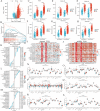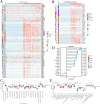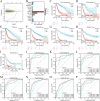ARHGDIB as a prognostic biomarker and modulator of the immunosuppressive microenvironment in glioma
- PMID: 40372473
- PMCID: PMC12081808
- DOI: 10.1007/s00262-025-04063-7
ARHGDIB as a prognostic biomarker and modulator of the immunosuppressive microenvironment in glioma
Abstract
Background: Glioma, a prevalent malignant intracranial tumor, exhibits limited therapeutic efficacy due to its immunosuppressive microenvironment, leading to a poor prognosis for patients. ARHGDIB is implicated in the remodeling of the tumor microenvironment and plays a significant role in the pathogenesis of various tumors. However, its regulatory effect within the immune microenvironment of glioma remains unclear.
Methods: The mRNA expression pattern of ARHGDIB was analyzed using public databases, and its expression was further validated in our collected cohort through quantitative PCR (qPCR) and immunohistochemistry (IHC). Kaplan-Meier survival analysis and LASSO-Cox regression were employed to ascertain the clinical significance of ARHGDIB in glioma. Subsequently, we systematically evaluated the association between ARHGDIB expression and immune characteristics within the glioma microenvironment, as well as its potential to predict treatment response in glioma. Additionally, in vitro experiments were conducted to elucidate the role of ARHGDIB in remodeling the glioma microenvironment and promoting tumor malignancy progression.
Results: Combined with bioinformatics analysis of public databases and validation with qPCR and IHC on our cohort, our findings indicate that ARHGDIB is markedly overexpressed in glioma and correlates with poor patient prognosis, thereby serving as a potential biomarker for adverse outcomes in glioma. Functional enrichment and immune infiltration analyses reveal that ARHGDIB is implicated in the recruitment of immunosuppressive cells, such as M2 macrophages and neutrophils, contributing to the alteration of the glioma immunosuppressive microenvironment and hindering the immune response. Further investigations through single-cell sequencing, immunohistochemistry, immunofluorescence, and in vitro experiments demonstrate that ARHGDIB exhibits an expression pattern akin to CD163, with its overexpression inducing M2 macrophage polarization and facilitating glioma cell proliferation and migration.
Conclusions: ARHGDIB emerges as a novel marker for tumor-associated macrophages, playing a crucial role in shaping the immunosuppressive microenvironment and representing a promising prognostic biomarker for glioma.
Keywords: ARHGDIB; Glioma; Immunosuppressive microenvironment; Prognosis; Tumor-associated macrophages.
© 2025. The Author(s).
Conflict of interest statement
Declarations. Conflict of interest: The authors declare that the research was conducted without any commercial or financial relationships that could be perceived as a potential conflict of interest. Ethical approval: All patients provided informed consent, and the ethics committee of XiangyaHospital, Central South University approved this study.
Figures






Similar articles
-
High expression of SIGLEC7 may promote M2-type macrophage polarization leading to adverse prognosis in glioma patients.Front Immunol. 2024 Aug 15;15:1411072. doi: 10.3389/fimmu.2024.1411072. eCollection 2024. Front Immunol. 2024. PMID: 39211050 Free PMC article.
-
S100A11 is a potential prognostic biomarker and correlated with tumor immunosuppressive microenvironment in glioma.Medicine (Baltimore). 2024 Dec 20;103(51):e40701. doi: 10.1097/MD.0000000000040701. Medicine (Baltimore). 2024. PMID: 39705426 Free PMC article.
-
Exploring the role of LOX family in glioma progression and immune modulation.Front Immunol. 2025 Apr 9;16:1512186. doi: 10.3389/fimmu.2025.1512186. eCollection 2025. Front Immunol. 2025. PMID: 40270974 Free PMC article.
-
Crosstalk between CD180-overexpression macrophages and glioma cells worsens patient survival through malignant phenotype promotion and immunosuppressive regulation.Mol Med. 2024 Dec 20;30(1):264. doi: 10.1186/s10020-024-01029-w. Mol Med. 2024. PMID: 39707188 Free PMC article.
-
Pan-cancer analysis identifies ADAM12 as a prognostic biomarker and indicator of immune infiltration in glioma.Sci Rep. 2025 Feb 21;15(1):6314. doi: 10.1038/s41598-025-90121-0. Sci Rep. 2025. PMID: 39984619 Free PMC article.
References
-
- Louis DN, Perry A, Reifenberger G, von Deimling A, Figarella-Branger D, Cavenee WK et al (2016) The 2016 world health organization classification of tumors of the central nervous system: a summary. Acta Neuropathol 131(6):803–820 - PubMed
-
- Okamoto Y, Di Patre PL, Burkhard C, Horstmann S, Jourde B, Fahey M et al (2004) Population-based study on incidence, survival rates, and genetic alterations of low-grade diffuse astrocytomas and oligodendrogliomas. Acta Neuropathol 108(1):49–56 - PubMed
-
- Stupp R, Mason WP, van den Bent MJ, Weller M, Fisher B, Taphoorn MJ et al (2005) Radiotherapy plus concomitant and adjuvant temozolomide for glioblastoma. N Engl J Med 352(10):987–996 - PubMed
-
- Martínez-Ricarte F, Mayor R, Martínez-Sáez E, Rubio-Pérez C, Pineda E, Cordero E et al (2018) Molecular diagnosis of diffuse gliomas through sequencing of cell-free circulating tumor DNA from cerebrospinal fluid. Clin Cancer Res 24(12):2812–2819 - PubMed
MeSH terms
Substances
Grants and funding
LinkOut - more resources
Full Text Sources
Medical
Research Materials
Miscellaneous

